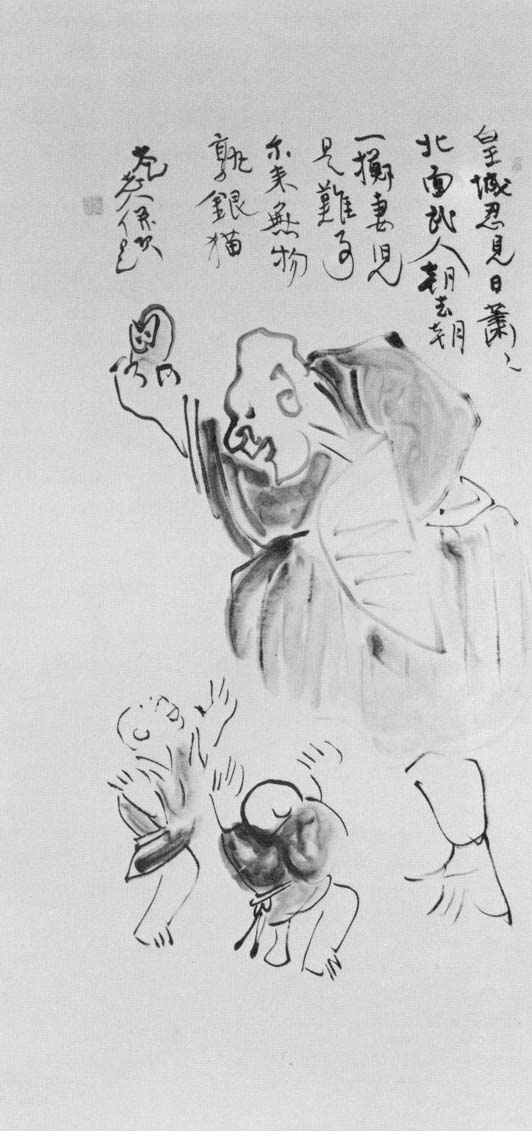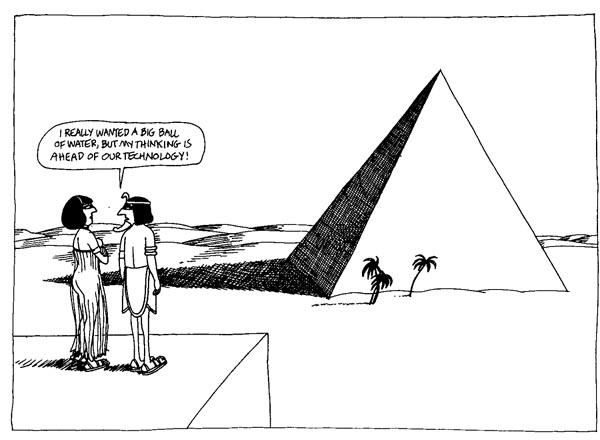I have just seen Vito Acconci's "Acts of Architecture" at the Contemporary Arts Museum in Houston. This is my first experience with his work. The museum calendar provides some general information about Acconci's career up to now, the different exhibitions he has had, something about furniture, and his ongoing study of viewer participation in art. It's a diligent blurb, and I have no quarrel with it, except to say that it doesn't quite mention the most important point, which is that this guy's architecture ROCKS. Here is a great example of unrealized architecture. This is the side of the spectrum that is just beyond buildable. In this exhibit, Vito Acconci has given us his architectural visions, checked only by the limitations of model construction materials.
What does viewer participation mean to you? There. That's how you draw someone into a discussion. But how do contemporary artists' draw viewers into their works? They do it with mirrors and other good old-fashioned chicanery. But the truth is, any art, all art can engage its viewers simply by—what was that—by KICKING ASS. And Vito Acconci's 'contemporary' architecture does just that. I propose we dump the entire framework of contemporary and-wait, just what is the word for the other kind of art? Not-contemporary, old, used to be contemporary but now it's not, washed-up, boring, Nazi-touched, left-over, residual, forgeable, sad art. 'Contemporary' as an organizational tool is no more evil than any other, but after what Acconci has just done, I think it's safe now to just refer to him as an artist. Just like I refer to Picasso as my bitch.1
For me, the most important element of any art, besides its technical prowess is its ability to create or resonate with a feeling, a mood within the viewer. Right now, the art which I like the most is that which I want to jump into. When I look at Van Gogh's paintings, for example, I want urgently and literally to be in them, to the point where I start sweating and feeling heavy. I need to be sitting at this café, strolling through this courtyard, making a payment on this yellow house or even freezing in this winter. And I want it now. That's when I know something is good.
Acconci's architectural models have this effect. By staring into the buildings themselves, you can visually and spiritually go inside them.2 A good architectural model, you may look at and wonder what materials were used to make it—a great one, you don't care. You're too busy wondering 'how can I shrink down and get in there?' In the exhibit, all of the models are placed at eye level inviting you to look closely (see chicanery). But there was one building in particular where you could put your face right up next to it and look inside. What I saw was dark and infinite like a cave,3 but I could see the light through the opposite end.4 There was the feeling of blue fluorescence and the suggestion of water. It was the Venutian version of New York's Central Station. Fantastic. There were other installations where he had placed little plastic people sitting appropriately on the grass or on benches, in enclaves or other spaces. You could be those people as you immersed yourself in the piece. This is not unlike the large Chinese scrolls depicting scenes of nature, in which the viewer is invited to lose himself on a tiny path between trees or next to walls within some wall-filled palace.5
Then there was the text. I first noticed it in his model for a school that is fragmented as if it had been blown up. He describes how the pieces of walls will act as giant chalkboards. Then he says children will use the chalkboards to make up their own language. At this point, I just about lost it. This is not just architectural modeling anymore. This is, well, you would have to call it poetry. On the one hand, you have the structure itself, which is cool enough to stare at, get lost in, be a fish in the water of and so on. But now you also have this wonderful text to chew on, rewrite for a moment in your head, and then fall back to the original, because, well, he's the artist, and you're nobody. Again there is a precedent in the Asian tradition of having scrolls that mix pics and poetic verse. Murase Taiitsu was one such artist who lived in Japan during the 19th century in the Edo Period, or as I call it, the only period. His poems relate to the paintings, yet either can stand alone just as well. Together, they combine to form the 'total experience' or what some have called 'looking at the scroll'. This combination of painting, calligraphy and poetry has been called The Three Arts of Murase Taiitsu.

It's sad to see the Imperial Palace daily more desolate,
Each dawn sees more samurai moving to the north.
Leaving one's wife and children is truly a hardship,
Since that time there is nothing but this silver cat.
In his pieces, in the poetry that accompanies them, there is a confidence in the rightness of his works. Of course, most of Acconci's structures are clearly unrealistic and unbuildable, and yet his descriptions or proposals remain totally dry and unwavering. I see this as one of the most enjoyable aspects of the works. There was this one big structure with lots of domes and ramps. I can't remember whether it was supposed to be a shopping center or what, but he said something like, 'people will see skate boarders skating on ramps…' It's as if the structure is so right for it, how could skateboarders not be there skating. Whether it's cars driving on roads, children climbing through tunnels in theoretical playgrounds, or birds converging on a proposed trash dump, his structures are such perfect incarnations of themselves that the outside world could not help but participate accordingly. And they would want to. I want to.
There is a roundabout that reacts to passing cars by altering its shape. It becomes larger and higher, with more cars around it, and then at night, when the cars are gone, it sleeps. There is the park where time obligingly reverses, and you re-enter your childhood. Oddly, this one was actually not the fastest to be rejected by city planners for being impractical. I am quietly hoping that some day, perhaps long after the flood, his visions will become a reality. If I were Ted Turner, that day would be next Thursday, the eleventh, and the U.S. and U.N. could suck on it.
1 Although in truth, Picasso, and I'm not talking about some younger version only a cohort of long-dead women have seen, I'm talking about the seventy-year old we all have in our head, definitely would and probably could kick my ass. But I take pleasure in the thought of the the dual title 'world class artist' and 'ass kicker.' Schwarzeneggar is a world-class specimen, but he can only grope at painting.
2 I sincerely pray I will never have to read the word 'spiritually' ever again in an essay.
3 Like a cave? Who is writing this crap?
4 I'm going to be sick through the opposite end.
5 The reader is invited to pull out a 2x4 and smash himself over the head with it, because that would be better than reading more of this crap.
